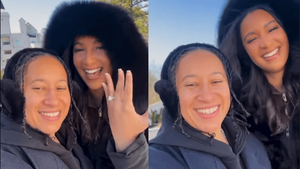During the throes of LGBTQ Pride Month, New York Magazine has just released a ranking of America's most powerful drag queens, paired with photographs that were taken backstage at RuPaul's DragCon in Los Angeles. And the final result is trash.
Sure, the photos are beautiful, taken by the extremely talented and renowned Martin Schoeller, who shot last year's Out 100. But the accompanying ranking is problematic AF, and here are four reasons why:
1. No drag queens actually helped with the list.
Why do we allow people who do not participate in the art of drag themselves to be the ones to judge it so much? There are a bunch of a people listed who reported and helped curate this ranking, and by the looks of it, it's mostly gay boys who only did drag that one time for Halloween.
But this issue isn't only isolated to the ranking.
Even on Drag Race, has Ru ever been joined by a guest judge who was actually another drag queen? I would much rather see Lady Bunny or Bianca Del Rio judge a queen than Bobby Moynihan, because they actually know what they are talking about it. A straight cisgender white guy judging drag is like a vegan judging a steak competition.
2. This list was only of contestants on RuPaul's Drag Race.
To say that the world's most powerful drag queens were all on Drag Race is limited, myopic and simply not true.
There are many queens who have established strong brands for themselves and are extremely influential outside the confines of that one reality show. Many of these queens happen to be from a different generation, because they did not have a TV show to go on to bolster their career. They had to do it the old-fashioned way, with years of hard work and determination.
This includes but is not limited to Lady Bunny, Peaches Christ, Coco Peru, Jackie Beat, Sherry Vine, Joey Arias, Varla Jean Merman, Chi Chi LaRue, Miss Richfield 1981, Heklina, Lypsinka, Dina Martina ... I could keep going.
Other queens like Vicky Vox, BibleGirl, the Boulet Brothers, Rhea Litre, Horrorchata, and Marti Gould Cummings have been able to create their own success without ever entering the workroom during this era of the show's popularity.
So why aren't they being acknowledged? Why aren't they on the list?
Many of these queens do attend RuPaul's DragCon, so they would have been there for photos. Highlighting the influence of drag in 2019 only through the queens of RuPaul's Drag Race seems like sponsored content from Viacom (the parent company of VH1).
3. The descriptions are lazy, sometimes shady, and full of mistakes.
As Evan Ross Katz pointed out on Twitter, many of the descriptions have factual errors that any editor or fact checker would have been able to discover if they had actually put some work into the piece. For instance, Alaska is originally from Erie and was on season 5 ... not 6.
But in addition to that embarrassing sloppiness, many of the descriptions, especially in their simplicity, come off as shady. From describing Chad Michaels as the oldest winner (and that's it) to only pointing out that Aja was criticized for having poor makeup skills, the reporters on this piece many times only point out a queen's weaknesses and leave it at that.
I'm pretty sure there is a lot more to Jujubee than the fact that she never won a main challenge.
4. Why are we ranking people?
It's one thing to rank the best travel destinations for 2019 or the best craft cocktail bars in New York City. But these are places and things that don't have feelings, even if they may be the result of someone's hard work.
However, ranking people just doesn't seem right when influence, power, and esteem are so difficult to compare, especially in an art form that's as diverse as drag,
I think it would be pretty shitty to be one of the queens listed in the Bottoms section of this list, who took time away from their booth or their many other obligations during DragCon to pose for the photographer. To now see their image being used for something that is predictable in its ideation, poorly executed, and then making a dig at them by saying they don't measure up to the other queens listed would surely be disappointing and upsetting.
It seems that, in fact, the queens did not know they were being ranked for this, as Willam wrote on Twitter: "No one told us they were gonna be ranking us but hey press is press. @vulture."
Sure, it's LGBTQ Pride Month, and all of a sudden every mainstream outlet wants the opportunity to generate traffic because it's trending. But this piece is another example of when mainstream media do queer content, they need to do it better. And while this is great in theory because it give us more exposure, when executed, it can fail.
I love that there are drag queens on the cover of New York Magazine, but I just wish they didn't have to be there for this.
Alexander Kacala is a commentator on LGBTQ culture and hairy chested drag performer. A contributing reporter at NBC Out and Instinct Magazine, Kacala hosts his own queer pop culture podcast, The Fayme Report. You can follow him on Instagram here.




































































Charlie Kirk DID say stoning gay people was the 'perfect law' — and these other heinous quotes